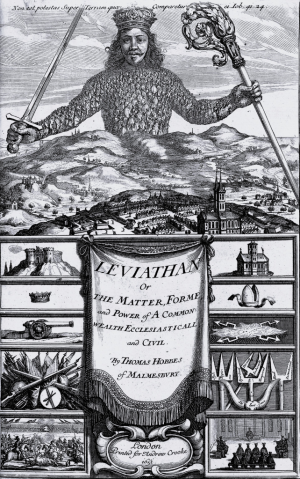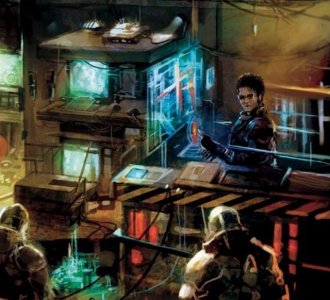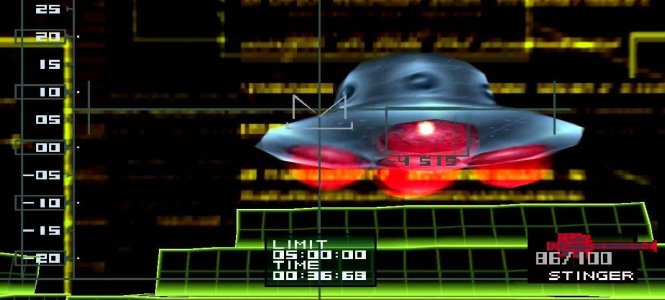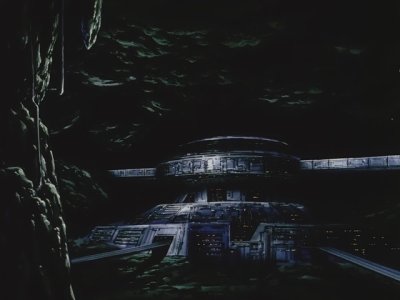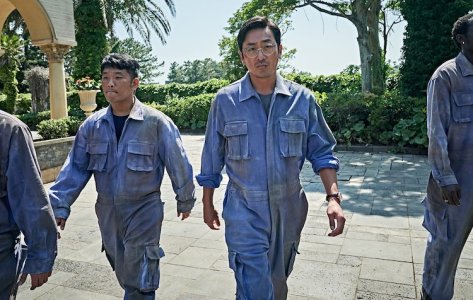U.N. Temple of Sol
The Sons of Centauri-Ra narrowly escaped the destruction of the
Unity via Landing Pod. They consisted of most of the ship’s solar sailer team: powertechs, solartechs, laborers, most of them belonging to the rising neopagan cult from the latter days of Old Earth. Along for the ride were survivors swept up along the way to the nearest hangar bay. Cuzco Sol, once Lucero Eztli Salvador, led the motley crew, boldly extolling the Centauri suns and exhorting all whom they came across to join them, so long as they renounced darkness and shadow. Their landing was hastily done under frightfully uncertain circumstances. Throughout the descent, Sol called upon Centauri-Ra to shine his faithful rays upon his children, so they may live to grow strong and powerful on this new mudball. Along that harrowing passage, new converts were born, existing faith was reforged in the reentry heat of the pod chassis. Shortly after, Sol unilaterally declared himself the spiritual and mission leader of the lost flock, annointing himself Heliophant.
They landed on gentle foothills surrounded by dense fields of xenofungus. The elevation was heralded by Sol as a good omen, “closer to Ra,” with the potential for solar collector developments. He called this new base Temple of Sol as both tribute to the sun cult and to his own humble zeal. So began the hardscrabble life of the Sons. It was a theocratic society but not excessively so. The brotherhood stressed vigorous activity and striving for perfection in the martial arts, which lent itself well to building and defending the colony. Sun worship was encouraged but not mandated. The macho attitude of the cult stressed each individual journey towards solar enlightenment. Believers often tried to outdo each other in the hunting of local megafauna, the erection of more solar collectors above quota, the more time spent outside under the sun. Those who were weaker in faith were mocked as effete, secret Earth-loving pansies, but left unpersecuted. So in their chauvinistic, yet open-natured way, the Sons eked out a passable society.
Temple of Sol was a functional base from the start, but survival was difficult and fraught with danger
Not long after its founding, Temple of Sol welcomed its first set of surprise visitors. They were non-hostile, unlike the bugs of the air and the beasts of the field. A corporate convoy carrying heavy equipment under the command of Dai Seung Heavy Industries passed through the territory of the Sons. These fellow survivors had landed quite some distance away, in desolate wasteland. Only with great difficulty and trepidation- and the best navigation that the company survival scouts could rustle up- did they narrowly evade worm attacks to arrive here. A mining and construction civilian contractor attached to the
Unity mission, the former chaebol was searching for a better site to set up shop, and hopefully, customers to sell to. Even if the mission was technically dissolved, the surviving executives reasoned, work could still be done to make use of the place. They were open to clients, and, taking note at the rather shabby and under-equipped nature of the Heliophant’s faithful, potential workers as well.
Headquartered in the Gangnam District of Seoul, Dai Seung was particularly well-positioned to form unlikely partnerships. The company had been the first to operate in the Koryoin Autonomous Oblast, the Soviet-occupied zone of the northeast Korean peninsula. With a corporate culture stressing adaptability, flexibility, and pragmatism as its highest values, Dai Seung would go on to operate contracts as disparate and far-flung as constructing nuclear power plants in the Vietnamese Soviet Republic to exploring offshore natural gas fields off the coast of French Indochina, building medical facilities for the post-Six Minute War Indian government to laying infrastructure for “Self-Sufficient” Japan’s disputed IOEZ naval holdings on Netaji Bose Island. While the field execs were at first apprehensive towards working with a batch of fanatically hypermasculine meatheads, they analyzed the situation quickly and cooly.
Vice President of Field Operations- Labor Relations Young Kwan-Yong surmised that the Centauri-Ra cult, while pugnacious and prone to atavistic flights of fancy (one of Heliophant Cuzco Sol’s first pronouncements was his intent to personally climb one of the nearby alien monoliths and carve the twin-sun sigil onto its capstone - he was only dissuaded from doing so when company reps proposed building their own obelisk for the cult’s ceremonies, rather than disfiguring the priceless ancient artifact), did indeed possess valuable technical expertise in solar power generation, and that their bravado could be harnessed under the chaebol’s guiding hand. He further determined that for all of their fighting ability, most were engineers, technicians, and workers without actual combat experience, and the amount of actual weaponry they held beyond improvised blades and bludgeons was paltry. While Dai Seung Security Services did not possess firepower akin to that of Sabre, SafeHaven, ARC, and the like, they did have more than the surviving solartechs had salvaged from the ship.
One of the dozen Dai Seung VPs who survived Planetfall, Young Kwan-Yong was an expert in brokering deals with workforces from many markets. His pre-Chiron claim to fame was reaching an accord with striking miners at Komdok in 2061
The Sons were not simpletons- they had long since abandoned their initial infamous tactic of attacking mindworm swarms in melee combat, swinging sledge hammers as clubs with broken photovoltaic cells as shields. And their insistence on ritually sunbathing in the light of Alpha Centauri A and Hercules did seem to offer salutary effects- Dai Seung Human Asset Management psych chaplains discovered that observant Centauri-Ra acolytes performed ably in battle against psi-wielding xenoforms, resisting hallucinatory effects for precious minutes longer than non-observant practitioners and non-members who lacked extensive off-base experience. Young asserted that this personnel resource could not be disregarded, and his partnership proposal was soon adopted by the Field Operations Working Board.
This working relationship was rocky upon inception with the Sons of Centauri-Ra scoffing at the idea of listening to corporate suits, but all was smoothed over as Dai Seung opened its modest armory of shredder pistols, penetrator rifles, field HUD scouters, even several prototype exo-frames used for heavy loading. Most importantly, the Agriculture and Food Synthesis Divisions upscaled to accommodate feeding a doubled population. While the Sons had a store of survival rations, the specter of starvation would not be fully banished until Dai Seung graciously shared its food supply. In return, the Sons got to work building out a full state-of-the-art (by pre-launch standards) electrical infrastructure. The Heliophant’s daily messages gave succor to the faithful, who rallied to the difficulties of frontier settlement. Dai Seung’s managers found that the sun worshippers were more than up to the task of settlement. They were particularly competent at defending against mindworms and hostile factions. While professional, the corporation’s Security Services were unaccustomed to savage irregular raids from Holnists, smacers, and mindworms. In exchange, the corporation allocated excess work cycles towards constructing shrines to appease their partners.
Dai Seung construction crews built the Shining Face, a massive idol of Helios placed in the Chamber of Initiates
After several mission years of independent operation, the Temple of Sol met its greatest threat yet: Spartan aggression. While the Colonel expressed amusement towards the mob of half-crazed sun lovers, and held their fighting spirit in some esteem, she had no patience for their corporate fellows. Denouncing the pursuit of wealth as decadent, Santiago charged Dai Seung as another horde of capitalist monopolists leeching off the truly productive protectors of society (this rhetoric was a sop to the remaining Holnists left in her Federation) and accused Cuzco Sol of falling prey to the lies of weak-willed energy worshippers. Indeed, the immense energy stores generated by the vast solar collectors built by the cult gave the base the makings of a future Merchant Exchange- and had crowned Young Kwan-Yong CEO of his company. To Young and staff, Dai Seung and the heliocentric brotherhood were after the same thing. Radiance meant reverence to some, riches to others. Far from accepting the claims of this provocateur, the Heliophant upheld the cult’s honor and declared that no Son of Ra may betray his friends to any outsider.
While brave, the base came under swift attack by an overwhelming force that outnumbered and out-organized the defenders. Deployed to the passes leading to the city, in the gaps of the xenofungus fields under the shade of Cuzco’s obelisk, the Saulė
calpulli and the 2nd Field Security Team ‘Chungmu’ saw their positions overrun by an army of helots. Low in morale, these meat-grinder captives taken from prior conquests were force-marched by their Spartan officers straight into the joint Sons-Dai Seung force’s firing lines. Some crawled
through the dense xenofungus themselves- company PR officers would later decry that as evidence of nerve-stapling on the part of the Spartans. Even as some corporate security personnel would shamefully break and flee from the onslaught, the Ra acolytes, their bloodthirst triggered, broke ranks to run
towards the enemy, taking out industrial-forged ceremonial
Huitzauhqui spiked bats and 3D-printed
Champi star-shaped maces and bludgeoned at the flood. For a shining instant, the gambit worked. The stunned Spartans’ momentum was thrown back by this vanguard, allowing the other defenders to hail storms of shredder flachettes. But this instant passed as Myrmidons outfitted in combat laser rovers and attack hoverbikes approached and blew past the defensive lines.
After second sunset, Spartans overloaded the Surya Agricultural Dome, denounced by Dai Seung as industrial sabotage and by the Sons of Centauri-Ra as blasphemous descecration
The Spartans had arrived at the perimeter walls of the colony. Defenders unleashed a variety of weapons upon them- anti-mindworm flamer guns, hot water pressure washers, even an experimental high-speed excavator arm. But these efforts were fruitless. Colonel Santiago had wanted the corporation as helots, the cultists as janissaries, and the city as her prize. Already her military communiques referred to the base as War Outpost. Visayas-born former PMC operator Arturo Quiepo, the invasion commander, had Myrmidons punch through the defensive perimeter with explosives. After several blasts and fending off a counterattack by the Aruna
calpulli with fire support from the 7th Base Security Division ‘Gasin’, the Filipino Spartan and his forces dove into Temple of Sol, ready to slay and enslave all within.
It was then a U.N. Peacekeeping Forces division miraculously emerged upon the scene. Having tracked Spartan troop movements closely for over a decurn as part of a long-simmering pseudo-vendetta, Major Steven Howard, the leader of the blue berets, invoked Article 5 of the Joint Signatory Framework, declaring that the Spartan Federation had attacked a neutral party, violating interfactional law. Armed with the latest impact weaponry, the Peacekeepers blasted the Spartan forces in the field before attacking their rearguard at the base’s walls. The invaders were caught by the hammer of Lal and the anvil of the Temple. Quiepo, no stranger to lost causes, ordered a speedy retreat, spitting threats of true vendetta upon the Peacekeepers as battered Myrmidons withdrew from the gates.
And so did the Temple of Sol make first contact with the Peacekeeping Forces. Major Howard was bemused to discover an independent settlement co-ruled by a religious organization and a private corporation. He would later describe the arrangement as “a distant echo of those weird big business-loving Midwest theocracies from the Second American Civil War.” Regardless of the unusualness of the arrangement, Howard quickly recognized Sol and Young as co-leaders of the city. Relief workers stayed to see to the wounded and the reconstruction, proper emissaries were exchanged, and the base was inducted into the Peacekeepers’ protective orbit.
Major Steven Howard and a Peacekeeper anthropologist granted an audience before Heliophant Cuzco Sol, flanked by Medjay elites
Several mission years later, the base expanded with Peacekeeper support. While they continued to train vigorously and ritualistically, diminishment of outside threats meant that the Sons of Centauri-Ra were able to focus fully on solar collector construction. The settlement became renowned as the “City of Ten Thousand Mirrors,” its vast solar arrays surrounding the countryside where xenofungus fields used to be, now plucked clean by Peacekeeper ‘formers leased to Dai Seung construction teams. Following no lack of polite prodding by Lal’s diplomats, the Heliophant and the CEO gradually acceded to entrance into the faction. Thus was the community renamed U.N. Temple of Sol, an odd rarity among the faction’s bases.
The commissioner and his advisors would later rue giving the place more than associate status: while its governors were democratically elected, they tended to fiercely advocate for cult and corporate interests. This ranged from the irritatingly monomaniacal (designating the Heliophant’s corporate-built shrines as UNESCO Planet Heritage Sites) to the alarmingly unhinged (favoring widespread adoption of hydrocarbon-producing vehicles and MULEs, both for cost-cutting reasons and for immanentizing Amun-Ra’s eschaton). But between the fervor of the cult and the professionalism of the corporation, U.N. Temple of Sol maintained a low population of drones. Even as both realized there was more to Planet beyond the base walls, their steadfast stewardship made the City of Ten Thousand Mirrors truly shine.
U.N. Temple of Sol at the cusp of the Pre-Sentience Age
In time, the story of both the Sons of Centauri-Ra and Dai Seung Heavy Industries diverged beyond this first base. Cuzco Sol’s departure for the south, the following succession struggles, the rise of the Proxima-Aten heresy, the various exoduses and pilgrimages that ensued, and the faith’s experiences living among other societies is beyond the scope of this account. Though of particular interest is the curious case of the small Centauri-Ra community within the Lord’s Conclave at Mount Sanctuary- like the Dharmic-based Kavithans of Thakurism, non-Abrahamic religions have always had an uneasy, often antagonistic existence within the the Conclave despite Sister Godwinson’s official credo of “life of religious worship.” Even more precarious is the state of the Solarus sect among the Stepdaughters of Gaia. A sororal offshoot originally welcomed by the Gaians as fellow nature-loving neopagans, they quickly drew the ire of the Lady herself for their belligerence and tendency to light entire groves on fire in devotion to the Heliades. Fortunately for both the Gaian hosts and the Solarii, Chiron’s low oxygen makes forest fires difficult to spread.
And as contact with ever more civilizations (and potential clients) increased, Dai Seung perpetual Acting Field CEO Young took up more contracts, forging partnerships beyond U.N. Temple of Sol. The company rebranded itself New Unity Industries, popularly known as Unicorp. Boasting the motto “The Only Answer to Tomorrow,” it would become a second-party developer to the Shapers of Chiron. Providing the engineering muscle and know-how to some of the movement’s most audacious mass terraforming projects, Unicorp also began to run into limits of its cultural adaptability. Even as Dai Seung had reformed on Planet and become an industrial giant as New Unity Industries, Young and his executives grew more assured in their own vision of how to run Planetary operations smoothly, often locking horns with the Coordinator. And the chaebol often pursued its own agenda independent of Nagao’s mystic quest, as it had done with the Sons. Unicorp often deviated from the main Shaper mission, waging its own trade wars and industrial espionage campaigns against the likes of Morgan and ARC, fighting for the hearts and wallets of Planet.
Regardless, the story of the Temple of Sol illustrates how sub-factional societies could exist and coexist on Chiron. Religious, cultural, even ideological identities did not always have to belong to a single faction or outpost. Private entities, whether corporate or otherwise, could work with multiple factions or even a single sub-factional society. The settlement of Planet continues to be a multivariate affair hosting a diverse array of radically different groups.
Casting
Young Kwan-Yong is portrayed by Ha Jung-woo as Kang In-gu on
Narco-Saints.
Steven Howard is portrayed by Kurt Russell as Jack O'Neil in
Stargate.
Notes:
The entire premise of this segment is to explain why there’s a
Peacekeeper base with the titular name. True story.
Unicorp, also known as New Unity Industries, founded as Dai Seung Heavy Industries, is from the custom mod faction set
SMACFacPack by Nathan Weismuller and Adam Gieseler. Unicorp is rather like an unabashed Morgan Industries, a corporation that is self-aware that Planetary monopoly results in Planned economics, and the Free Market is an impediment to that.
txt file here
Arturo Quiepo is from
Far Cry 2.
Major Steven Howard is from
Mercenaries: Playground of Destruction.
The Solarii are a hero unit in
Majesty: the Fantasy Kingdom Sim, worshippers of the sun goddess Helia.
My design for the Sons of Centauri-Ra are meant to have a good amount of Mesoamerican cultural influence in addition to Egyptian, Greek, and other ancient sun worshipping societies. So their military units are organized into
calpulli and they initially fight with modern adaptations of
Aztec and
Inca weaponry. Each calpul is named after solar deities from different traditions, from
Baltic to
Hindu.
For Dai Seung / Unicorp, I gave their Security Services units nicknames, as is common in the
Republic of Korea Army.
Chungmu (충무), “loyal valor,” is a posthumous name given to great military commanders of the Joseon Dynasty.
Gasin (가신) are protective household deities in Korean shamanism.
Thakurism / Thakurite belief is the religion of the
Kavithan Protectorate from Civilization: Beyond Earth.
Image Credits
Space colony base on magenta planet is the
box art from Sierra On-Line game Outpost
Room with giant golden face statue is a
submission for a Solarpunk-themed Atomhawk art challenge by Tom Sterckx
Burning dome with wicker man on top is from
Burning Man 2013, photo by Andy Barron/Reno Gazette-Journal via AP
Futuristic solar-arrayed city is “
Solarpunk” by
Steven Wong
Adaptation Notes
Removed references to a Korea divided along historical lines.
My original rendition of Young Kwan-Yong was female- I felt the gender imbalance of the SMAC Fac Pack was too heavily skewed, unlike that of SMAC. Upon reflection I’ve decided to keep it along the original creators’ intent. I had cast
Kim Hye-soo from
Default (2018), South Korean drama film about the 1997 Asian financial crisis.

